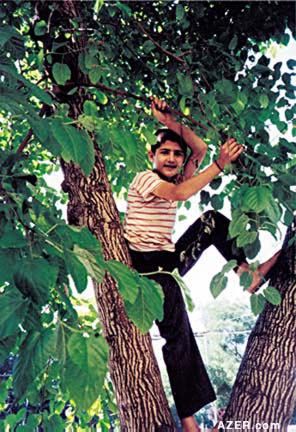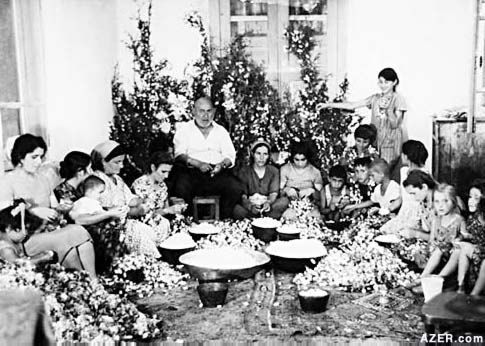|

Autumn 2000 (8.3)
Silk Road
The Origin
of the Mulberry Trees
by
Farid Alakbarov and Iskandar Aliyev

Above: Shaki, a city in northwestern
Azerbaijan, was a large center for silk production. Since the
collapse of the Soviet Union, production has been greatly reduced.
Photo: Blair
Fresh
mulberries are so fragile and perishable that they have not yet
been grown commercially in the United States, making them very
rare and sought after - especially in California. Restaurant
chefs have been known to line up for hours at outdoor markets
to buy these fashionable berries at $10 to $15 a pound. In the
Los Angeles area, some Iranian immigrants have even resorted
to planting their own mulberry orchards so that they will have
easy access to their favorite fruit. But in Baku, mulberry trees
can be found in parks and lining streets and boulevards. It's
one of the favorite fruits.
This sweet, juicy berry is by no means a newcomer to Azerbaijan.
By the Middle Ages, there were already many different types of
mulberries in the region, including varieties like aghtut, khartut,
chardagli, shahtut, bidana, kharji (seedless), Shirvani, Tehrani
and garatut. There are three main species of mulberries - white,
red and black - all of them widely cultivated throughout Azerbaijan.
The white mulberry in particular grows in the forests stretched
along the Kur, Araz and Samur rivers.
_____
To pick mulberries, a person - often a young boy - climbs the
tree and shakes the branches, causing the fruit to drop onto
a cloth or plastic sheet below. The berries are very delicate
and therefore need to be handled carefully so that they don't
break open - the stain won't wash out.
Azerbaijanis don't grow mulberry trees just for their fruit,
however. In the summer, residents in the villages around Baku
used to sit and drink tea or play nard (backgammon) in the cool
shade of mulberry trees. There's a square in the Old City (Ichari
Shahar) that takes its name after the tree. Even a song has been
written about the mulberry tree.
  Today, mulberry trees
(most frequently those bearing black fruit) line the streets
of Baku and lend shade to courtyards. In the countryside, mulberry
trees are often found in orchards and courtyards, along with
a variety of other fruit trees like cherry, fig, pomegranate,
apricot, apple and pear. Today, mulberry trees
(most frequently those bearing black fruit) line the streets
of Baku and lend shade to courtyards. In the countryside, mulberry
trees are often found in orchards and courtyards, along with
a variety of other fruit trees like cherry, fig, pomegranate,
apricot, apple and pear.
Left: Mulberry season in
June as evidenced by the tell-tale purple stains on tree-climbing
youth. Photo: Blair
Originally, male (fruitless) mulberry trees were planted along
the streets and in the parks of Baku in order to provide shade
and decoration. But somehow it happened that some female trees
got planted as well. When their fruit becomes ripe each June,
it tends to drop to the ground and stain the sidewalks. That's
how you know it's mulberry season in Azerbaijan - that and kids'
faces stained with the dark purple juice.
Mulberries as Medicine
When mulberries are no longer in season, Azerbaijanis still enjoy
eating them in the form of mulberry syrup concentrates known
as "doshab" and "bakmaz". To make the syrup,
mulberry juice is boiled until it has a consistency that's much
like honey.
While this syrup makes a tasty sweet, it is also used as a medicine
to protect against diseases of the liver, gall bladder and heart.
To treat gallbladder infections, one is supposed to drink 2 tablespoons
of bakmaz dissolved in half a glass of water, then lie down in
bed on his or her right side. The treatment should be taken on
an empty stomach, half an hour before breakfast.
Bakmaz is used to treat sore throats as well. In 1836, Abbasgulu
Agha Bakikhanov, a famous scholar and son of Baku's last khan,
sent several bottles of bakmaz to his friend Dmitry Bibikov,
who headed the Department of Foreign Trade in Russia. Bakikhanov
wrote: "Dear Sir...According to my promise, I am sending
you a box of bottled syrups. Two of them are of mulberry, one
of quince, and the smaller one, sour plum (goyam)...
Mulberry syrup is good for use against throat pain. Apply the
syrup on the throat externally, cover with a cloth and keep this
compress on all night. You can also drink the mulberry syrup
a little bit at a time or mix it with soup. Quince syrup is good
for a weak stomach and strengthens it, whereas sour plum syrup
adds a cooling sourness to foods. If you would like, I could
send you more syrups."
Tut araghi, a potent liqueur (vodka) made from mulberry juice,
is another mulberry product that's very popular - not only Azerbaijan,
but also in Georgia and Armenia. It's one of the national Azerbaijani
versions of vodka. Another type is zogal araghi (vodka made of
cornelian cherry). Some people believe that small doses of these
drinks protect against diseases of the stomach and heart.
Food for Silkworms
Azerbaijanis have found many uses for other parts of the mulberry
tree, such as boiling the roots to make black dye and making
the wood into furniture and musical instruments. But by far,
the mulberry tree's most significant impact in Azerbaijan has
been on its silk industry. Leaves from white mulberry trees are
used to feed silkworms in order to make the product that gave
the Silk Road its name.
Azerbaijan's Shirvan region started becoming known for its silk
industry as early as the 9th century. By the 11th and 12th centuries,
the silk produced in Shirvan was already famous throughout Russia
and Western Europe. Silk cloth was exported to Italy by Venetian
and Genoese merchants who maintained commercial offices along
the shores of the Caspian.
In 1293, Marco Polo himself wrote that the Genoese ships were
engaged in the silk business in the Caspian region. He writes:
"Shirvan dwellers make golden and silk clothes. You can't
find such beautiful things anywhere else."

Above: A typical family scene
in the early 1960s when neighbors would gather to help each other
clean silkworm cocoons in preparation for silk production in
Balakan. Courtesy: Sadikhova
Similarly, Adam Oleari, a traveler who visited Shirvan in the
17th century, wrote that Azerbaijan produced up to 2.5 million
kg of silk cloth each year. In the town of Shaki alone, 14,000
families were engaged in silkworm breeding and produced approximately
15,000 poods (240 tons) of raw silk each year. Part of this silk
thread was exported; the other part was woven and dyed in local
factories.
During the Soviet period, leaders like Brezhnev wanted to substitute
cotton for the silk industry in Azerbaijan. Even so, Shaki kept
its thriving silk industry, employing thousands of people up
until the collapse of the Soviet Union.
Mass Planting
In 1961 Azerbaijan's Cabinet of Ministers issued a decree to
encourage silkworm raising. According to a series of five-year
plans, 3.8 million new mulberry trees were to be planted each
year, all over the Republic.
The decree encompassed 42 different regions of Azerbaijan, including
the Nakhchivan Autonomous Republic, Aghdam, Aghjabadi, Astara,
Balakan, Beylagan, Gakh, Gubadli, Gabala, Gazakh, Zangalan, Masalli,
Saatli, Sabirabad, Tovuz, Ujar, Khanlar, Khachmaz, Jalilabad
and Shaki. For instance, in Aghdam, where growing conditions
were good and there was already a considerable amount of agriculture
going on, 324,600 mulberry trees were planted.
To distribute seeds for these new mulberry trees, the Ministry
of Agriculture organized a Seed Center. Before the Center was
organized, mulberry seeds had to be imported from Uzbekistan,
Turkmenistan, Russia, Ukraine and other Soviet republics.

Above:
The traditional
way to gather mulberries is for someone to climb up the tree
and shake the branches so the mulberries fall on a sheet below.
Courtesy: National Archives of Photo and Cinema
These seeds were then distributed to families living in the areas
where the silk industry was to be developed. The families also
received tiny silkworm eggs, which were kept in matchboxes.
It's not an easy task to look after silkworms. You have to put
the silkworm eggs on mulberry twigs with leaves. The silkworms
eat the leaves and then spin a large cocoon as they encircle
themselves with silk. Once the worms produce enough raw silk,
the cocoon has to be removed and cleaned. Families were paid
by the kilo for the cocoons that were produced.
Silkworm raising was especially prominent in the regions of Balakan
and Zagatala, up in the mountains close to the Georgian border.
The families who participated had to have enough room for mulberry
trees in their garden as well as time for raising the silkworms.
The white mulberry (Morus alba) was their primary food. Sometimes
neighbors would gather together to help clean the cocoons.
Mulberry trees were also planted in regions where people didn't
raise silkworms, in order to help produce mulberry leaves for
the regions where there was a silk industry.
Following the collapse of the Soviet Union, silk production in
Azerbaijan shrank to next to nothing, though it is still quite
a thriving industry in Kazakhstan. Instead of planting millions
of mulberry trees each year, the Azerbaijani government only
plants a few thousand.
In the town of Shaki, the silk factory no longer hums with the
activity it once did. Who knows whether the industry will ever
be revived to the extent it was in the past. In the meantime,
the trees are living proof of an era that once thrived along
the famous Silk Route that crisscrossed Asia and Europe for centuries.
Farid Alakbarov provided the historical background of the medieval period
for this article while Iskandar Aliyev described the Soviet
period of the 1960s when Baku planted so many of the mulberry
trees that line its streets today. The Los Angeles Times
was our source for ideas relating to the contemporary craving
of Southern Californians for this delicacy. See "Fruits
of California: Berry Frenzy: Mulberries are the Fruit People
Go Nuts For" by David Karp, July 19, 2000, page H1. Staff
members Farida Sadikhova and Arzu Aghayeva also
contributed to this article.
_____
From Azerbaijan
International
(8.3) Autumn 2000.
© Azerbaijan International 2000. All rights reserved.
|